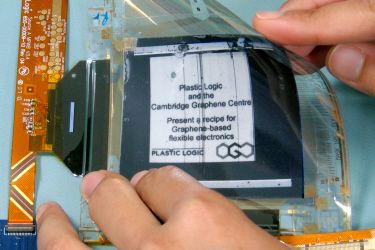The partnership between the two organisations combines the graphene expertise of the Cambridge Graphene Centre (CGC), with the transistor and display processing steps that Plastic Logic has already developed for flexible electronics. This prototype is a first example of how the partnership will accelerate the commercial development of graphene, and is a first step towards the wider implementation of graphene and graphene-like materials into flexible electronics.
Graphene is a two-dimensional material made up of sheets of carbon atoms. It is among the strongest, most lightweight and flexible materials known, and has the potential to revolutionise industries from healthcare to electronics.
The new prototype is an active matrix electrophoretic display, similar to the screens used in today’s e-readers, except it is made of flexible plastic instead of glass. In contrast to conventional displays, the pixel electronics, or backplane, of this display includes a solution-processed graphene electrode, which replaces the sputtered metal electrode layer within Plastic Logic’s conventional devices, bringing product and process benefits.
Graphene is more flexible than conventional ceramic alternatives like indium-tin oxide (ITO) and more transparent than metal films. The ultra-flexible graphene layer may enable a wide range of products, including foldable electronics. Graphene can also be processed from solution bringing inherent benefits of using more efficient printed and roll-to-roll manufacturing approaches.
Graphene is more flexible than conventional ceramic alternatives like indium-tin oxide (ITO) and more transparent than metal films. The ultra-flexible graphene layer may enable a wide range of products, including foldable electronics. Graphene can also be processed from solution bringing inherent benefits of using more efficient printed and roll-to-roll manufacturing approaches. – See more at: http://www.cam.ac.uk/research/news/first-graphene-based-flexible-display-produced#sthash.gNeMPcvo.dpuf
Graphene is more flexible than conventional ceramic alternatives like indium-tin oxide (ITO) and more transparent than metal films. The ultra-flexible graphene layer may enable a wide range of products, including foldable electronics. Graphene can also be processed from solution bringing inherent benefits of using more efficient printed and roll-to-roll manufacturing approaches. – See more at:

